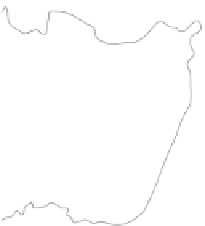Agriculture Reference
In-Depth Information
products of a burgeoning population of humans with
increasing disposable income (Shrestha et al., 2008). One
outcome of the United Nations Conference on Environment
and Development in 1992 held in Rio de Janeiro was the
ratifi cation of the Convention on Biodiversity. This pro-
moted national and international attention toward the
depletion of biological diversity, a trend that includes
goats. To combat the loss of goat genetic resources world-
wide, many countries have seized opportunities to initiate
in situ and ex situ conservation to preserve the inherent
potential of goats and reduce the endangerment or extinc-
tion of breeds, populations, and landraces.
Goat provides a sizeable proportion of the human diet
in many developing countries. Through owning animals
with multifunctionality, small farmers and the landless
have survived in the face of hunger, poverty, and the
current food crisis (Devendra, 2007). The genetic resources
of goats are not unique to each country but instead are
affi liated intimately with the economic status, social struc-
ture, religious rituals, and most importantly, public policy.
Therefore, preservation of animal genetic resources is nec-
essary to sustain current production levels and to address
future market demands for commodities, trade, fertilizer,
breeding stocks, employment, and recreation. No longer
are goats viewed as pests responsible for soil erosion.
Instead, goats are being viewed in new roles as potential
alleviators of worldwide poverty.
ronment provided by farmers. Wild species undergo physi-
cal changes as they adapt to captivity and are selected for
traits of economic importance. Clutton - Brock (1999)
defi ned a domestic animal as “one that has been bred in
captivity for purposes of economic profi t to a human com-
munity that maintains total control over its breeding, orga-
nization of territory and food supply.” Domestic animals
that revert to their wild state following their escape or
release into an environment favorable for propagation are
known as “ feral ” animals.
As early as 8500 BC, prehistoric people at the end of
the Mesolithic period raised herds of goats and fl ocks of
sheep in the mountainous areas bordering Iran and Iraq
(Figure 3.1). This conclusion is based on archeological
excavations where goat and sheep bones were uncovered
adjacent to human settlements along with radiocarbon
dating. Archaeological sites in the Kermanshah Valley of
the Zagros Mountains at “Ganj Dareh,” Iran (8000 BC)
and the Euphrates river valley at “Nevali Cori,” Turkey
(9000 BC) are believed to be two separate but distinct sites
where domestication occurred (Vigne et al., 2005). Other
possible sites of domestication include the Indus Basin at
“ Mehrgarh, ” Pakistan (7000 BC), “ Cay ö n ü , ” Turkey
(8500 - 8000 BC), “ Tell Abu Hureyra, ” Syria (8000 - 7400
BC), “ Jericho, ” Palestinian Occupied Territories (7500
BC), and “ Ain Ghazal, ” Jordan (7600 - 7500 BC). The
central Anatolia and the southern Levant also have been
proposed as additional sites of early domestication. New
research has confi rmed that the “ Ganj Dareh ” site contains
the earliest directly dated evidence of livestock domestica-
tion (Zeder and Hesse, 2000 ).
DOMESTICATION
Domestication is an ongoing process that includes both
artifi cial selection and skillful breeding practice in an envi-
ARMENIA
AZERBAIJAN
TURKMENISTAN
TURKEY
CASPIAN
SEA
Tabriz
Daryachech-ye
Urumlyeb
Rasht
Babol
Mashhad
Mosul
-
Tehran
SYRIA
Kirkuk
CYPRUS
Tripoli
Hims
Hamadan
Dash-e-kavir
LEBANON
Malee
Tharthan
Beirut
Kashan
MEDITERRANEAN
SEA
AFGHANISTAN
Damascus
I RAN
Baghdad
IRAQ
Haifa
Esfahan
Karbala
as
Tel Aviv
Amman
Jerusalem
Yazd
An Nasiriyah
Hawral
ISRAEL
JORDAN
Kerman
Figure 3.1
Region where early domestication of goats and sheep occurred.
































































